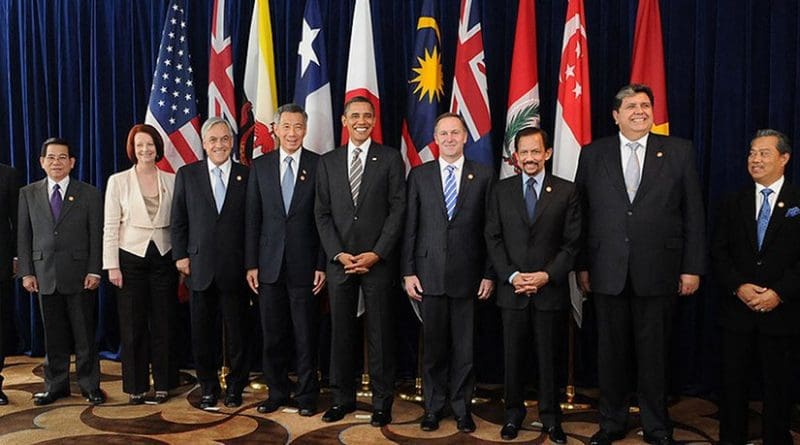Future Of TPP And US’ Pivot To Asia – Analysis
By IPCS
By Sandip Kumar Mishra*
In the first round of the presidential debates in the US, it became certain that the Trans-Pacific Partnership (TPP) is still far from being realised. While the Republican candidate, Donald Trump reiterated his opposition to the TPP, even the Democrat candidate Hillary Clinton stated that she is not in favour of it in its present form. This stance is understandable for Trump, who has been a supporter of protectionist policies, but more salient is the shift in Clinton’s approach, who worked for the conclusion of the TPP when she was the Secretary of State. In fact, current US President Barak Obama has still been trying to get the deal ratified by the US Congress.
Hillary Clinton’s shift is posited in a domestic environment of growing unrest in the US over the TPP. It is alleged that the TPP is going to be less beneficial for US’ small and medium businesses and for the employment scenario and it has become politically difficult for any candidate to support the TPP as it would have adverse implications on their electoral success.
TPP is a trade agreement among twelve countries of the Pacific Rim, which, after numerous rounds of discussions, was finally signed in February 2016 in New Zealand. Its ratification is still in process, post which it would come into force. The TPP was incorporated in US policy in 2008 to reengage with the Asia Pacific by excluding China. Later on it was considered to be an important component of the US pivot to Asia. The TPP was supposed to conclude in 2012 but it got prolonged because of both political and technical reasons. After a topsy-turvy journey, in February 2016, it appeared that the TPP would finally become a reality but the recent mood in the US seems to point to the fact that the process is far from over.
The change in the public disposition appears to be an important reason for the US presidential candidates to distance themselves from it. If the deal is not ratified by the US, it means that the US’ influence and connections in setting up the economic rules of Asia Pacific is going to be seriously reduced. In July 2016, the US Trade Representative admitted, “a failure to ratify TPP would give China the opportunity to boost its exports and set labor and environment standards in the fast-growing Asia Pacific regions through the Regional Comprehensive Economic Partnership (RCEP)”. Even the US President Barak Obama said “if we don’t pass this agreement – if America doesn’t write those rules – then countries like China will”.
Many US allies in Asia-Pacific, such as Japan, Singapore and Australia, look forward to a greater role of the US in the regional economic architecture and they would be deeply disappointed by the current political atmosphere in the US. If the TPP does not materialise, the ties with the US would not hold much value for them, except for empty words and past performance, at least in the economic domain. Singaporean PM Lee Hsien Loong’s statement to Obama sums up the general sentiment of the American allies in the region, “your partners, your friends who have come to the table, who have negotiated, each one of them has overcome some domestic political objection, some sensitivity, some political cost to come to the table and make this deal. And if, at the end, waiting at the altar, the bride doesn’t arrive, I think there are people who are going to be very hurt, not just emotionally but really damaged for a long time to come”.
Contrary to the US, China has improved its economic clout in the region very decisively. China, which is the number one trading partner of more than 112 countries in the world, certainly has taken the task of being the economic pivot of Asia-Pacific. China’s initiatives such as One Belt One Road (OBOR) and Asia Infrastructure Investment Bank (AIIB) appear to be future frameworks along with the RCEPs that would shape the rules, norms and institutions of economic exchanges among the countries of the region.
Even though there are significant concerns about the China’s political and military assertion in the region, US’ allies had no option but to somehow, reluctantly, deal with the attractive economic propositions by the Chinese and wait for the TPP to conclude. Japan is going to take up the TPP ratification issue in its ongoing 66-day extraordinary session of the parliament. Shinzo Abe tried to convince Hillary Clinton about the TPP in his recent visit to the US. Australian PM Malcolm Turnbull, in his September 2016 visit to the US, also urged the US congress to ratify the TPP as soon as possible “as it goes beyond economics”.
Here it is important to underline that though the US government is aware of the significance of the TPP and is willing to get it ratified however it is the current domestic disposition that hampers the process by not allowing any presidential candidate to support the deal. It indicates the existing reality, that even though the US government is interested in a pivot towards Asia, it’s capacity to do so is increasingly getting reduced. It may prove to be an advantage for China but Beijing also needs to be aware about spoilers such as its own political and military stances and the picture is still not clear.
* Sandip Kumar Mishra
Associate Professor, Centre for East Asian Studies, JNU & Visiting Fellow, Institute of Peace and Conflict Studies (IPCS)

